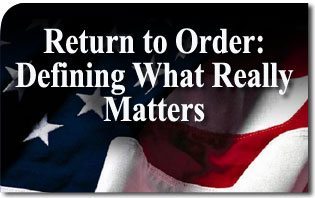 In that tumultuous and troubled decade of the sixties, one of the revolutionary mantras of the generation was, “Suppose they gave a war and no one came?” Such a pacifistic fantasy is the stuff of which utopian dreams are made. Such an unrealistic fantasy should remind us, as well, that when espousing cultural change, it is wise to use ideas and systems which have successfully endured in the past.
In that tumultuous and troubled decade of the sixties, one of the revolutionary mantras of the generation was, “Suppose they gave a war and no one came?” Such a pacifistic fantasy is the stuff of which utopian dreams are made. Such an unrealistic fantasy should remind us, as well, that when espousing cultural change, it is wise to use ideas and systems which have successfully endured in the past.
The concept of using all that was, and is, best from our past is very much at the heart and soul of John Horvat II’s Return to Order: From a Frenzied Economy to an Organic Christian Society—Where We’ve Been, How We Got Here, and Where We Need to Go. Mr. Horvat succinctly examines not only the economic history of Western civilization, but offers a penetrating examination of America’s social history as well.
In Return to Order, the author logically offers that a problem cannot be truly solved until the subject is comprehensively understood and the issues are well-defined. To this end, he not only pinpoints what is wrong with today’s mass-production, pop-culture advertising and frenzied consumerism, but offers a postmortem on the Western world from its organic beginnings in the Middle Ages, in a predominantly agricultural way of life, through the Renaissance, the Industrial Revolution, and on to Wall Street and the ensuing IT Age and its global marketplace.
This is not a tedious book on Economics 101 with bar graphs, pie charts and equations. Rather, it is a veritable autopsy of the social and monetary guts of commerce in our culture. In terse, comprehensive chapters, reduced to short succinct paragraphs, the subject is broken further into informative, insightful prose sound-bites that linger long after the book has been closed.
In examining the beleaguered economy of 2013, Mr. Horvat has recourse to a tried and tested business axiom: Pinpoint and solve the biggest problem, and many lesser, internal negatives will vanish as the process corrects itself.
In following through with this exercise, we find that the national deficit, gigantism, global manufacturing, and international trade are symptomatic of America’s evolving, and devolving social and economic dilemmas. Our fractured society is splintering under the blows of deconstructing qualitative relativism, failing values, and eroding regionalism. International mass-production, dehumanizing technology, and pop culture dictate the status quo, and it is readily apparent where our problems, complex, and long in the making, dwell. America has lost its roots.
With considerable deliberation, Return to Order, after an overview of economic history from the Middle Ages to the Second World War, follows the trace elements of the “American dream” from the Eisenhower years and a defining point in our society: post-modern individualism.
Favoring Individuality Over Individualism
Mr. Horvat comments:
“We make a distinction between individuality and individualism. Individuality is that which characterizes a person who develops his own personality and talents which makes him different from others while respecting the social character of man. The more specific, richer, and stronger the personal life, the more intense the social life. Thus, great individuality results in stronger community… Individualism is a deformation of individuality in which the individual closes himself up in a world of his own self-interest thus denying the social character of man.”
Post-modern individualism involves the fragmentation of society, which atomizes itself through radical self-interest, and then rejects communal and familial values, traditional spirituality and even gender roles. The end result of these layered and overlapping equivocations is simply schizophrenia, on an individual, familial, communal, regional and national level. Our problem is not economical. Our dilemma is that we have rendered our culture undefinable. We have, from the “happy” days of “Leave It to Beaver” (wherein lay the pernicious poisons of both self-interest and malaise) to the multi-cultural relativism of 2013, leveled all playing fields. We have created a society in which nothing is sacred (i.e., worthy of respect), and our disposal-all lifestyle (from contact lenses to marriage) is promulgated by advertising campaigns which explicitly promise “happiness” if product “X” is purchased, but implicitly keeps the consumer needy as newer, faster, bigger, better innovations are developed. In short, Pavlovian conditioning and “carrot-on-a-stick” merchandising make our world turn.
Gone are the days when consumers dictated what they needed and wanted. And in that turning of the worm, lies the root of our problem. We have altered from organic, regional symbiotic relationships of demand and supply between consumer and manufacturer, to an anonymous business of manufacturer to middle man to buyer. If the former economy fostered pride in craftsmanship as much as monetary gain, the latter’s only end is accumulation of wealth. Greed, as the driving force of any economy relying upon mass production, and the destruction of regional produce, results in mediocrity and a loss of both quality and artistic value. To please and appeal to many, compromises must be made. And, as Mr. Horvat points out, the rouse of personal choice, as offered by fifty varieties of corn-flakes, is nothing more. Further, as gigantism’s conglomerates accumulate more and more brand names and their owner’s anonymity increases, their advertisers are canny. In an astonishing, back-handed salute to hearth and home, even as the products become more synthesized, they are sold as “good as home-made,” or “just like grandma used to make.”
With that said, one might think that the author is opposed to the entrepreneurial spirit, free trade, global markets, or capitalism. On the contrary, Mr. Horvat does not espouse insular commerce, but rather, makes marked distinctions between frenzied trade and consumption, and temperate, self-sufficient economic independence. One’s next door neighbor might not be building cars, computers, or television sets, but they might be offering produce that will help sustain your community or region. And it is with this idea that Return to Order makes a beautifully simple recommendation, perhaps implicitly; when you can buy local, you increase your autonomy by doing so. Remain mindful of a hierarchy of consumerism. Support your neighborhood, your community, your town, your state, your region, your country…. Your culture. Your world. And, in that order, as practicality allows.
As a baby-boomer, while reading Return to Order, this reviewer was carried back to his early years, to an era when the family doctor was a friend. Foods were purchased at the neighborhood corner grocery store, and a trip to the store often meant a ten-minute conversation with the grocer. My parents knew the milk man, the newspaper boy, the delivery man who picked up and returned my father’s laundered shirts and ties, and the insurance man, who dropped by – with clockwork precision – for his monthly premium payment, a cup of coffee and idle banter. This is a remnant of the organic society which Return to Order espouses. This is not a “suppose they gave a war and no one came” pipe-dream. It was, within my lifetime, a reality, and if issues developed in any arena they were handled before they became problems. That was the nature of the quasi-familial bonds created in commerce fifty years ago.

potency and inherent energy of Western European Civilization.
Although not mentioned up to this point, it is at its core a book about Christian spirituality. All of the examination of community, society, history and commerce ultimately leads back to the primary Cause. We have slowly and surely turned from a spiritually-rooted society to one sinking in the quicksand of materialism. Thus, we have devolved from a kind of economy of “upright spontaneity” which served the community even as entrepreneurs were made wealthy, to the paradox of the “frenetic intemperance” of mass production which peddles happiness with one purchase, and unhappiness if the superseding improved model is not immediately snapped up by consumers. We can continue to buy all of the latest iPods, computers, cars, gadgets etc., with helpful nudges from advertisers, but we will never come close to a kind of contentment which money cannot buy. It is as simple as that.
The heart of this book lies firmly in a belief in the greatest ideals of the American dream vitalized by a wellspring that hearkens back to the potency and inherent energy of Western European Civilization. Its soul is Christian, but more, its taproot is Catholic. It is, however, catholic, as well, in its universal appeal to reason, logic and balance as well as Faith.
At the least, Return to Order is a treasure trove of historical and social facts, wide-ranging, broad, and deep in its source material, the obvious result of long contemplation and years of research. It is, indeed, a book to be carried about and dipped into at regular intervals. Its views on family life, working relationships, art and letters, and spirituality have a potency which is life enhancing, and, if implemented, a life-style changer. Once read, regardless of your previous views of Western civilization, Christianity, Catholicism and the American Dream, I suggest your perception will be enriched and profoundly altered.

